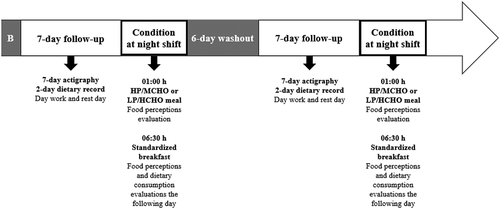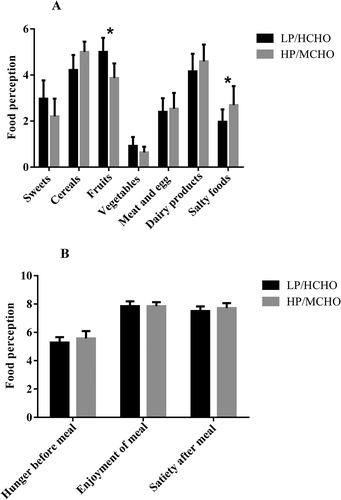Article title: Effect of consuming a late-night high-protein/moderate-carbohydrate vs. low-protein/high-carbohydrate meal by night workers on their food perceptions later during the day: A randomized crossover study
Figure 1. Protocol design of study. Abbreviations: B: baseline; HP/MCHO: high-protein/ moderate-carbohydrate condition; LP/HCHO: low-protein/high-carbohydrate condition.

Figure 2. Difference of perceptions regarding food groups between both conditions before standardized breakfast (2A) and perceptions regarding the same meal (standardized breakfast) in the low-protein/high-carbohydrate (LP/HCHO) and high-protein/moderate-carbohydrate (HP/MCHO) conditions (2B). Data represented as mean ± standard error of mean (SEM). Generalized Estimating Equation (GEE) was used to analyze the interaction between condition and perceptions before and after breakfast standardized. *Significant difference between conditions (p=0.014 for fruits and fruit juice; p=0.041 for salty products). For hunger, enjoy the meal and satiety: p=0.592; p=1.000; p=0.628 respectively.

Table 1. Baseline characteristics of participants
Table 2. Comparison of total food consumption the following breakfast of both conditions
Table 3. Food perception and consumption per meal the following breakfast of both conditions
Authors: Catarina Silva, Nayara Cunha, Maria Mota, Luisa Pereira Marot, Kely Raspante Cerqueira Teixeira, Thulio Marquez Cunha, Cibele Aparecida Crispim
Journal: Chronobiology International
DOI: 10.1080/07420528.2020.1807561
This manuscript has been previously published without its tables and figures. The tables and figures should appear as follows
